The Wei Wai Kum Guardians, established in 2018, work with partners to protect, restore, and monitor the ecosystems their people have relied upon for millennia. Their efforts help the Nation maintain a presence in their territory, make careful decisions about resource use, and continue traditional stewardship practices.
Wei Wai Kum Guardians: In the Steps of Our Ancestors
Estimated Reading time

25 Mins
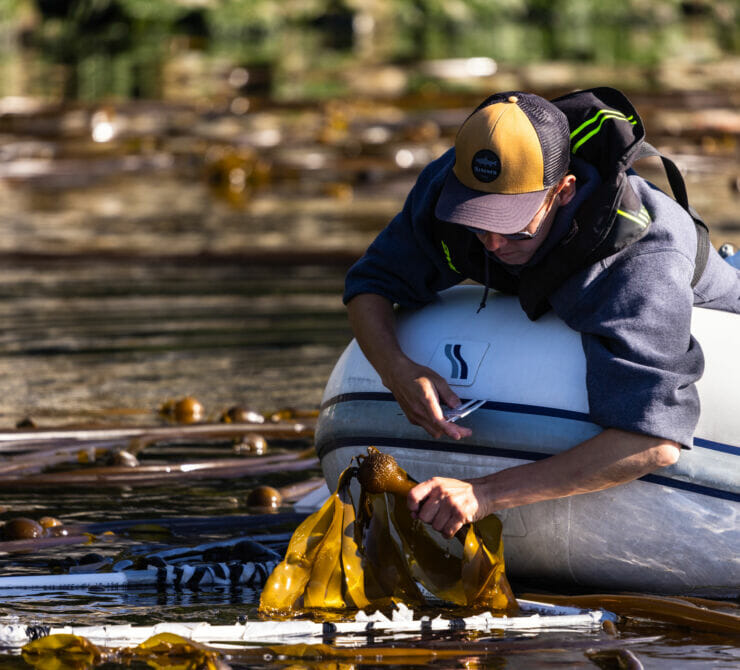
Through the Guardian program the Wei Wai Kum, many of whom live on reserve in Campbell River, are monitoring and gathering data in their traditional territories, which extend from Topaze Harbour and the headwaters of Loughborough Inlet south to Tsable River.
At a Glance
The Wei Wai Kum, who are part of the Laich-Kwil-Tach group of First Nations, have cared for and relied upon the lands, waters, and wildlife in their territory since time immemorial. Through their Guardian program, the Wei Wai Kum are applying traditional knowledge and using scientific techniques to carry out their stewardship responsibilities in a modern way.
Since its founding in 2018, the program has grown from three to nine Guardians who work to patrol the Nation’s territory, conduct research, restore salmon habitat, and partner with Crown agencies and industry to monitor impacts on lands and waters. Through the Guardian program, the Wei Wai Kum maintain a presence in their territory – keeping watch over what’s happening and ensuring that visitors and resource users are following local rules.
Led by Guardian Watchmen Manager Karl Smith, the Guardians collect scientific data, observations, and thousands of photos each season. This information is brought back to the band council and helps elected councillors and hereditary leaders make informed decisions about resource use and development in Wei Wai Kum territory.
“In the Steps of Our Ancestors”
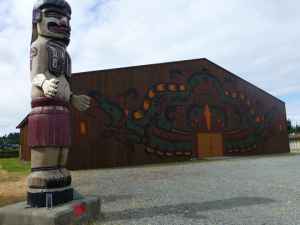
For thousands of years, the Wei Wai Kum people have lived along Johnstone Strait and surrounding inlets, near what’s known today as Port McNeill, Campbell River, and Quadra Island. Their traditional territory runs between the headwaters of the Loughborough Inlet, north of Campbell River, to the Englishman River to the south, west to the central mountains of Vancouver Island, and east through the Strait of Georgia.
The Wei Wai Kum are part of the Laich-Kwil-Tach group of First Nations – which also includes the We Wai Kai, Kwiakah, and Walitsima / Kahkahmatsis – the southernmost group of the Kwakwaka’wakw peoples who share the Lik’wala language, a dialect that’s closely related to Kwak’wala.
Their ancestors drew their strength from the abundant resources in their territory: salmon, herring, ducks, shellfish, berries, roots, and cedar. Each of these resources, and their territory as a whole, required careful management in order to thrive and support the needs of communities along the coast.
“We’re taught in our own histories that there are very specific roles [our ancestors played],” says Chris Roberts, elected Chief Councillor of the Wei Wai Kum First Nation.
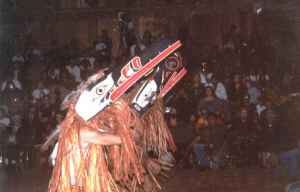
Laich-Kwil-Tach knowledge keepers have passed down stories and laws that describe the relationship Wei Wai Kum have with their lands and waters, and their people’s obligations to observe changes and manage ecosystems in an adaptive way.
“We hear stories of [our ancestors] transferring salmon eggs from a stream in cedar baskets to other streams, knowing that the conditions weren’t right [for the salmon to thrive],” says Chief Roberts, highlighting an example of how his ancestors helped fish adapt when streams were too warm or didn’t have enough water flow.
By monitoring the health of harvesting sites, communities could make decisions about when and where to harvest, whether to grant permission for visitors and passersby to harvest, and how to support the health of the animals and plants the Wei Wai Kum relied upon.
“For plant medicines and shellfish, the closer [harvesting sites] to the village would be for younger children and women who weren’t going as far from the main village sites,” says Chief Roberts, illustrating how resources were managed in a way that met community and ecosystem needs. “There is still a lot of that traditional knowledge to inform how we should be doing things in the modern context.”
The Wei Wai Kum’s ancestors understood the vital connection between their people and the animals, plants, lands, and waters in their territory, and honoured salmon, cedar, and other living beings through ceremony.
There is still a lot of that traditional knowledge to inform how we should be doing things in the modern context.
“We use this word in Kwak’wala: maya’xala,” says Chief Roberts. “It’s one of our values to practice respect for all things and support citizens’ well-being.”
Their Guardian program is one way that the Wei Wai Kum people continue to practice maya’xala and fulfill their responsibility to care for their territory and the abundance it holds.

Knowing Their Territory
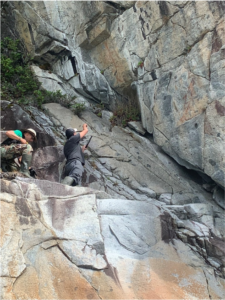
Today, 350 (nearly half) of Wei Wai Kum members live in the Nation’s reserve community located within Campbell River, a city of 35,000 about halfway up the eastern side of Vancouver Island.
In the surrounding area, several industries – from fish farms to forestry to real estate – are competing for resources and space. The Discovery Passage, which narrows to just 750 metres wide in some parts, runs north from Campbell River and Quadra Island and connects to the Johnstone Strait, and sees heavy traffic from cruise ships, cargo ships, fishing boats, and passenger ferries.
In these narrow passages, storms and strong tides can stir up 10-foot waves that can capsize or damage small boats – some of which end up derelict and abandoned along shorelines, presenting a spill and contamination hazard.
How can you manage your territory…if you don’t have current information on what’s happening out there now?
With so much happening in their territory, community members have expressed concerns over resource depletion, spill risks, and environmental impacts that could threaten the fisheries the community has relied on for generations. And, through Na̲nwak̲olas Council, the Wei Wai Kum First Nation receives 35 to 40 referrals a month for consultation on development and resource use.
“There’s all types of third-party interests in our territory – everything from logging, agriculture, new private docks, you name it,” says Chief Roberts. “Elected Chiefs and committees …end up with a stack of papers on all these interests that everyone else has.”
To manage these requests and referrals, the Nation draws upon traditional use data on archaeological sites and areas of cultural importance, guiding development away from sensitive areas. Though, as time goes on, it has become clear to the Wei Wai Kum that, in addition to its historical interests, the Nation has current, future, and economic interests that needed to be accounted for as well.
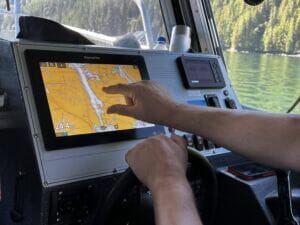
“We were finding that we just didn’t have a lot of information to base the decisions off,” says Chief Roberts. “So that to me, is the starting point as to why Guardian Watchmen programs are so important.”
To move forward, the Nation needed accurate, reliable information to support council decisions on development that can impact fish, ecosystems, and features that are critical to the Wei Wai Kum’s cultural identity and connection to lands, waters, and wildlife in their territory.
“How can you manage your territory – how can you be a steward and caretaker? – if you don’t have current information on what’s happening out there now?” asks Chief Roberts.
With so much of the data on their territory generated by outside groups with their own interests, it was important for the Wei Wai Kum to take a lead role in identifying priorities, developing a monitoring plan, and working with their stewardship office to gather objective data and observations.
Good information supports good decisions. With so many competing priorities and conflicting data sets, the Guardians act as the Nation’s “eyes and ears” and help to represent their people, gather information, and lead stewardship efforts.
“Our [stewardship] obligation, how we uphold it in a modern way, is with Guardian monitoring programs and [Wei Wai Kum] participation in conducting modern, Western science, combined with our traditional knowledge, which results in, I think, the most informed decision,” says Chief Roberts.
Establishing a Guardian Program
Karl Smith, an energetic man in his mid-50s, works as the Wei Wai Kum First Nation’s Guardian Watchmen Manager and assists with the band’s natural resources portfolio. He’s at his best when he’s behind the wheel of the Guardian boat and has a keen sense of what’s happening in Wei Wai Kum’s marine territories. From his captain’s seat, he can point out abandoned vessels, forest cut blocks, waterfront mansions, and channels where the current draws in sediment and small fish – natural buffets for humpbacks, porpoises, and seals.
“The salt water – it’s in my blood,” Smith says. “I was brought up on the ocean, out [fishing] with my grandfather every summer.”

Over his career, Smith has continued to spend time on and near the water as a commercial fisherman, a port security guard, and an environmental consultant – and brings a wide mix of skills to his work leading a team of Guardians tasked with monitoring and caring for his Nation’s land and marine territories.
As Guardian Manager, Smith is responsible for hiring, training, and scheduling work for nine Guardians. Along with lessons on marine safety and sampling techniques, he reminds his team of their role in serving their Nation.
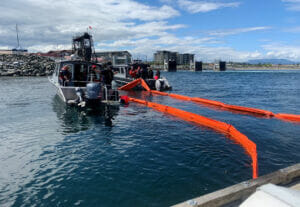
“We’ve been here for thousands of years and it’s our responsibility to care for our territory,” says Smith. “It’s an honour to work for your people, to represent them, and be out here helping to preserve and protect our [lands and waters].”
To fulfill that responsibility, the Wei Wai Kum established its Guardian program in 2018. Before then, the Nation’s stewardship program was “more informal”, says Chief Roberts, and the Wei Wai Kum would partner with neighboring First Nations to gather information on what was happening in their territory.
“We didn’t have fancy swag and gear or logos on things – we didn’t even have a vessel,” he says.
As a member of Na̲nwak̲olas Council, Wei Wai Kum First Nation participates in the Ha-ma-yas stewardship network, which provides technical, logistical, and data management support for Indigenous Guardian programs. Through Ha-ma-yas, Wei Wai Kum stewardship staff members participate in training and joint monitoring initiatives with other Na̲nwak̲olas members, gaining valuable knowledge on how to run a modern Guardian program.

To form their own Guardian team, the Wei Wai Kum hired a full-time Guardian Manager – Karl Smith – and allocated budget for additional Guardians, training, and supplies.
In Smith’s first months on the job, he built the program up from its roots: developing a safety plan, sourcing a boat and equipment, organizing training and work assignments, and applying for grants and securing contracts to sustain their operations. With support from the band council and external partners, the Guardians have tripled in ranks – growing from three to nine members in just three years.
“No two Guardian programs are alike,” says Smith. Each First Nation’s program is designed to support the community’s priorities for monitoring, restoration, and enforcement in its territory.
We’ve been here for thousands of years and it’s our responsibility to care for our territory.
And no two days are alike either. As a coastal people, the Wei Wai Kum’s stewardship obligations cover both land and ocean and their Guardians work long hours to gather and log data, monitor industry activity, complete restoration work, protect archaeological sites, and respond to emergencies – all while keeping a close eye on their territory and ensuring local rules are followed.
“People ask what our job is,” says Smith. “From what I see, [Guardians] are a blend of DFO officer, conservation officer, natural resource officer, and Coast Guard officer – set up for the needs of First Nations. It’s really challenging to juggle all the different jobs.”
“We do so so much,” adds Martel Henderson-Brown, 25, a member of the Guardian team. “The main part of our job is protecting our territory: doing our surveillance, making sure people aren’t [mistreating] our lands and waters.”

Surveying the Kelp Forest
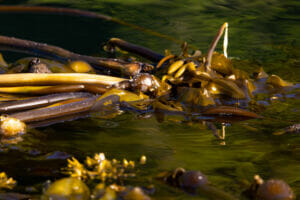
Stewardship is a community responsibility and all Wei Wai Kum members play a role in sharing knowledge and helping to inform the Guardians’ priorities.
As an example, a few years back, Chief Roberts recalls that Wei Wai Kum fisherman noticed that bull kelp forests were declining and shared their concerns with council. “[Bull kelp] is a key component to an ecosystem for forage and… the other ecosystem values it provides,” says Chief Roberts. “And government science knows that too.”
Bull kelp, a type of marine algae, has a one-year lifecycle and needs sunshine, cool waters, and a rocky ocean floor to thrive. During the sunny summer months, kelp can grow by as much as six inches in a day. When kelp forests are healthy, they provide food, shelter, and habitat – helping to anchor whole marine ecosystems. The fronds (or blades) and stipes (which look like stems) help to slow ocean currents, providing refuge for sea otters and a safe space for fish to lay eggs.
“The summer months are the peak of their lifecycle,” says Smith. “Then they start to die off – that’s when you see them float.”

In the fall, floating kelp fronds release spores, which drift to the ocean floor and clump together. When the days grow bright again, the spores will sprout into the next year’s kelp forest, beginning the cycle anew.
With climate change, that cycle is under increasing threat. Since the 1970s, oceans have absorbed more than 90 per cent of the excess heat trapped in the atmosphere, according to a report from the UN’s Intergovernmental Panel on Climate Change. Warmer oceans hinder the kelp’s growth, especially in southern regions.
Of the kelp that’s left, “the purple urchins are consuming it all,” says Smith. Sea urchins have two natural predators, he explains: sea stars and sea otters. In 2013 and 2014, a marine heatwave hastened the spread of sea star wasting syndrome, causing a massive die-off of sea stars. In the absence of a key predator, the urchins have increased in size, numbers – and appetite. The sea otters, whose numbers are still recovering after the end of the maritime fur trade, haven’t been able to keep up.
To track the kelp and gauge whether restoration efforts are working, the Wei Wai Kum Guardians are working with other First Nations to monitor the health of the kelp and observe changes from year to year.
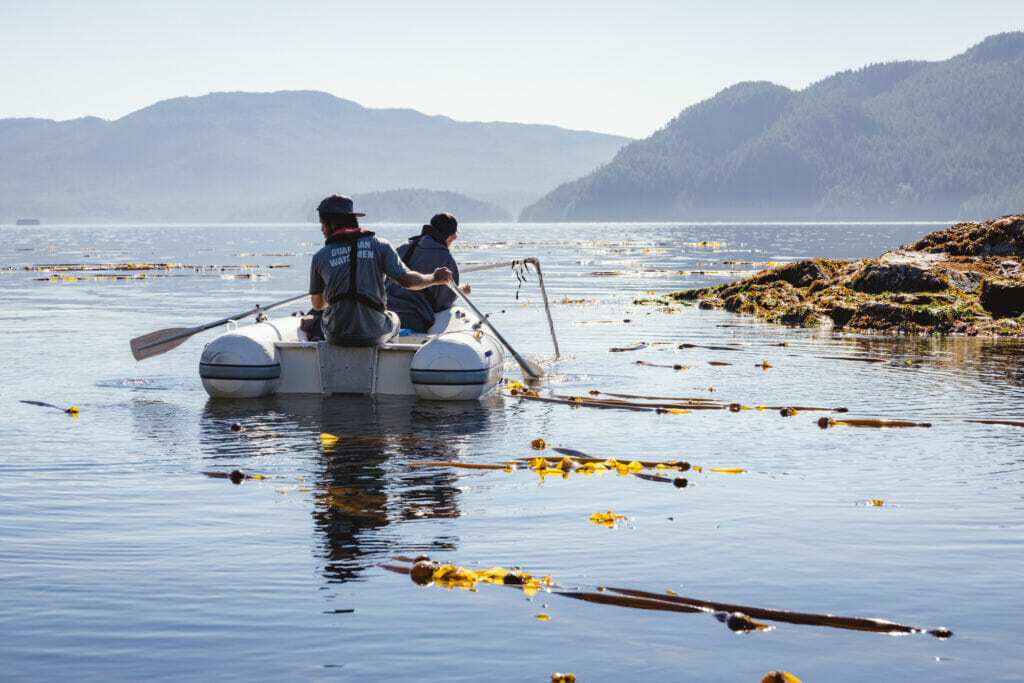
The Guardians go out during low tide – when the kelp is closest to the surface – and conduct perimeter and biomass surveys. With drones, they film kelp patches from above, logging footage that can be compared with previous years. This type of comparative data is essential for Indigenous and non-Indigenous leaders to make sound management decisions.
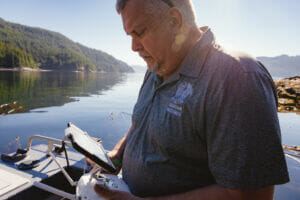
For the perimeter survey, Smith takes the Guardian’s boat around the edges of the kelp forest and logs GPS coordinates and water depth – measurements that can determine the overall size of the kelp forest.
To conduct a biomass survey, a pair of Guardians hop into an inflatable boat and – one square metre at a time – count the kelp bulbs, measure the stipes, check for disease, and note the number of urchins and sea stars present. While one Guardian measures, another records the observations, which help to assess the health and mass of the kelp forest.
It’s tedious and careful work – to get the level of detail needed, the Guardians use a quadrant (a one-metre square made of plastic pipe) to log data that’s representative of the kelp forest as a whole.
Once logged, Smith sends the biomass data, perimeter survey, and drone footage back to the band council, the Ha-may-yas stewardship network, and to the Wei Wai Kum’s partners. He hopes that, with solid evidence of the kelp forests’ decline, governments will increase their efforts to protect the kelp and contain the urchin population.
“Giving Back to the Fish”

“Helping the fish, that’s how I first got started,” Smith says. In his previous role as an environmental consultant, he monitored fish farms, bridge replacements, and forestry operations, with an eye to assessing industry impacts on valuable salmon populations. In his work with the Guardians, he’s applying those same techniques to gather data and restore the habitats salmon – and, in turn, the Wei Wai Kum – rely on.
“It’s neat – we’re giving back to the fish…helping them survive, getting their numbers up, and creating more habitat for them to spawn,” he says.
The Wei Wai Kum Guardians are currently working with Fisheries and Oceans Canada (DFO) on a three-year project, using radio tags to track the movement of sockeye salmon into Heydon Lake. Each radio tag costs about $1,000 and must be carefully inserted through a fish’s mouth into its stomach. Smith can place a tag in under a minute, without needing to sedate the fish.
The Wei Wai Kum know that the sockeye begin migrating through Heydon Creek and into the lake in August, says Smith. With the radio tags, DFO and the Wei Wai Kum will have a more accurate picture of where the salmon are spawning. With this kind of data, the Nation and its partners can prioritize habitat restoration initiatives to help salmon stocks recover.

The Nation’s partnership with DFO is a unique one, Smith says, especially given DFO’s comparatively short – and fraught – history in managing salmon stocks.
In addition to the radio tagging, the Guardians spend five months each year counting salmon at the Wei Wai Kum’s camp on Loughborough Inlet. As the salmon come through the gates, the Guardians face stiff competition from grizzly bears, who also depend on salmon, coming to the water for an easy snack.
“I’m counting the fish and they’re busy trying to eat them,” laughs Smith.
Restoring Estuary Habitat
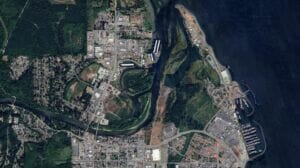
Just north of their urban reserve lands, the Wei Wai Kum Guardians have partnered with the K’ómoks Guardians, the City of Campbell River, Greenways Land Trust, the Guardians of the Mid-Island Estuary, and other groups on a long-term project to restore juvenile salmon habitat on Baikie Island and in the Campbell River estuary.
In the 1930s, forestry companies began using the estuary to gather, mill, and ship logs and lumber, Smith explains. To build timber yards and log booms, industry buried and dredged the wetlands and tidal marsh that link the land and the sea, damaging valuable habitat.
“They drove machines right into the water, where they boomed the logs, took them out, and put them back,” says conservation consultant Jim Van Tine in the National Observer. “We had a fisheries scientist here and we looked through the area and we couldn’t find one remnant of what might make food for fish.”
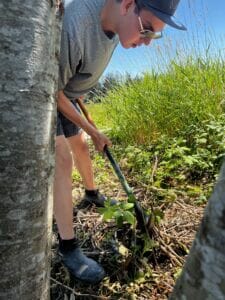
Estuaries, where rivers and oceans meet, act as nurseries for fish, birds, and an abundance of wildlife, says Camille Andrews, habitat management coordinator for Greenways Land Trust, which works to support conservation along the Discovery Coast. “From an economic point of view, [a healthy estuary] is so important for salmon. It’s a place for them to grow before they head out to sea.”
Over the past 20 years, the City of Campbell River, the Wei Wai Kum, and local conservation groups have been working to undo the damage and bring back the habitat and plant life that salmon need to grow and thrive.
As part of the restoration efforts, the Wei Wai Kum Guardians have been working to remove invasive plants – like Himalayan blackberry and scotch broom – from Baikie Island, so that native plants like eelgrass and carex grass can grow back. On a hot summer day, removing prickly berry bushes and deep-seated roots is tough work.
“Every year, we get a little bit closer to making the estuary invasive-plant free,” says Andrews, who points to the Wei Wai Kum Guardians as key partners in that effort.
Another invasive species? Non-migratory Canada geese, introduced by wildlife agencies in the 1970s. The geese weigh three to four kilograms and consume about 10 per cent of their body weight in food each day, says Tim Clermont, a conservation specialist with the Guardians of the Mid-Island Estuary Society (GMIES).
With few predators, the goose population has grown to over 15,000 and the geese have been gorging themselves on the carex grass that salmon rely on for food, shelter, and shade.
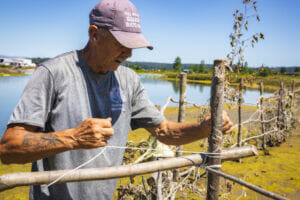
To mitigate the damage, the Guardians have partnered with GMIES to design and build exclosure fencing made from alder posts and willow branches, based on traditional techniques. Geese prefer open spaces and need more “runway” to take off and land, explains Clermont. The fencing breaks up their flight path and limits their line of sight, keeping them away from sensitive marshes.
“It’s almost artistic in the way that we build those habitat fences,” says Clermont, with GMIES. The fencing is made from traditional materials and resembles ancient fish weirs. “It’s gotten a lot of notice by others in the community and from tourists.”
Through their efforts in the estuary – and other sites in their territory – the Wei Wai Kum Guardians are reasserting their role as stewards and helping the salmon they’ve depended on for millennia.
“I hope salmon come back in bigger numbers,” says Smith. “We’re working to sustain [populations] in the long-term, so we can eventually harvest the fish.”
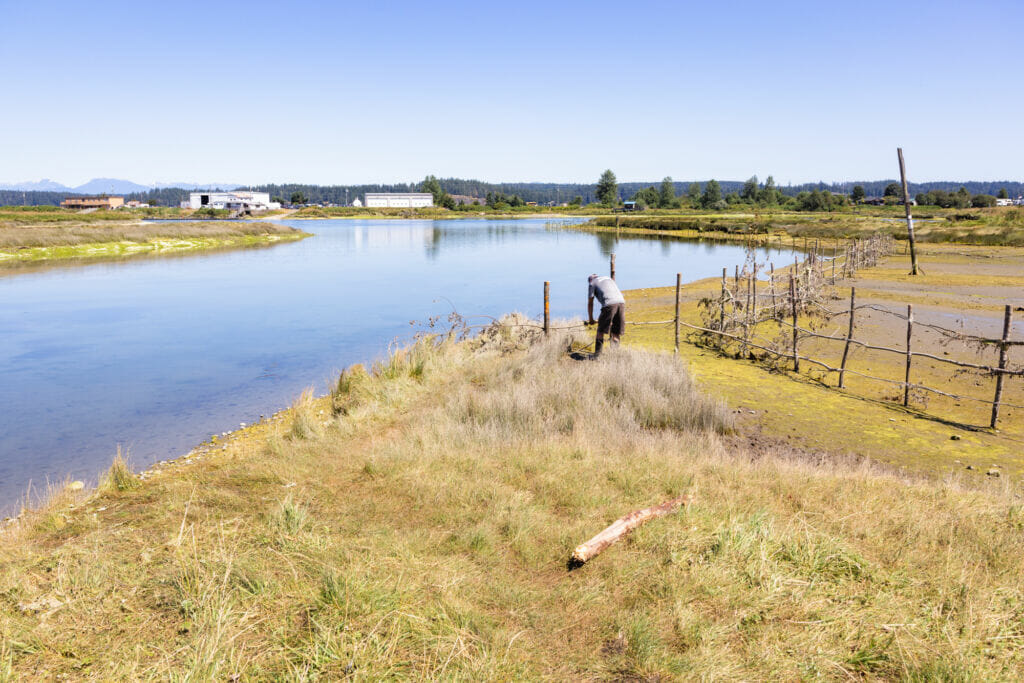
Close Partnerships

From habitat restoration to marine spill response to salmon enumeration, much of the Guardians’ work is carried out in close partnership with other First Nations, Crown agencies, local governments, and conservation groups.
Over the course of a year, they conduct work with and on behalf of BC Timber Sales, BC Hydro, DFO, the Coast Guard, conservation and natural resource offices, fish farm and forestry operators, and environmental groups. Through these partnerships and contracts, the Guardians bring in much-needed revenue and gain access to equipment, training, and insights that help them to fulfill their responsibilities to the Nation.
“Every year, I meet new organizations as part of the referrals process, and they ask our band for support,” says Smith. “You name it, from salmon to kelp to seagull surveys, it’s an endless amount of stuff that’s going on in the territory over the summer.”
As an example, through an agreement with the Na̲nwak̲olas Council, the Guardians surveyed 50 archaeological sites this year – up from 20 sites surveyed last year. Using GPS and iPads, the Guardians visit shell middens, rock art, and village sites to log their condition, exact positions, and sizes. That data is shared with Na̲nwak̲olas, and with the band office.
From salmon to kelp to seagull surveys, it’s an endless amount of stuff that’s going on in the territory over the summer.
“We use [this data] for referrals,” explains Smith. If industry wants to log or build close to an archaeological site, the band council will have the information they need to provide a recommendation on whether the request should be granted.
The archaeological work also helps the Wei Wai Kum to preserve their culture and traditions, says Martel, who’s worked as a Guardian for about a year. “With our younger generation…so focused on other things… I find that we lose more and more of our history and culture. Being out here, I get to relay what’s going on.”

Through the Ha-ma-yas stewardship network, the Wei Wai Kum Guardians have built strong relationships with Guardians from neighbouring First Nations and they come together to conduct joint projects, share knowledge, and encourage each other in their work. For Smith, that encouragement comes with competition: in his mission to “run the best Guardian program” on the island, he’s built up a friendly rivalry with his friend Cory Frank, who leads the K’ómoks Guardians.
Smith and the Wei Wai Kum have also formed a close partnership with the We Wai Kai, their sister nation, which is starting its own Guardian program. Since the We Wai Kai haven’t acquired their own Guardian vessel yet, their members join the Wei Wai Kum to survey their shared territory and monitor fish farms.
One of the Wei Wai Kum Guardians, Jordan Labbe, is a member of We Wai Kai First Nation, says Smith. “He’s working for us, but he’s representing his own First Nation. So, if he makes any observations, he can report them to his Chief and council.”
Within the Campbell River area, the Guardians have built a reputation as hard workers who take a long-term, big-picture view on stewardship and conservation. Through partnerships, the Guardians share their stories and traditional knowledge, and help conservation groups to be more aware of changes in the ecosystems, both seasonally and over time.
“[The Guardians] have such positive attitudes and never get tired of the work they’re doing, never complain about the weather,” says Andrews, who works with Greenways Land Trust. “Between them all, they have a really broad skillset. There’s always someone that’s able to come forward as a natural leader.”
“They’re highly trained… and they’re proud of the work they do,” says Clermont, who works with GMIES. “It’s hard work and they manage to do it with a smile.”
Looking to the Future
With so much happening in Wei Wai Kum territory, there’s no shortage of work for the Guardians.
“It’s endless what you can monitor out there,” says Smith. “But our work is limited with just one boat…I can’t put the Guardians everywhere.” Looking forward, he would like to see the Guardian program grow, so that he can employ Guardians year-round and cover more of the Nation’s territory.
“Our priorities are to continue to grow, and to balance [the marine stewardship] with the terrestrial side,” says Chief Roberts. He envisions a strong Guardian program, whose work is carefully integrated with the decision-making processes of elected and hereditary leaders.

“We need to make a concerted effort to close the loop on the research that is taking place to inform [leaders] on the issues and concerns that we’re aware of, so we can have decisions that we feel good about, can live with, and stand behind.”
Working with Na̲nwak̲olas Council and Coast Funds, the Wei Wai Kum have developed a 10-year stewardship vision and is fundraising to grow its access to self-determined revenue.
Our work is limited with just one boat…I can’t put the Guardians everywhere.
“We don’t have enough money to [run a Guardian program] in a way that would give us the freedom to really be autonomous,” says Chief Roberts. In order to access funding and equipment, the Guardians collaborate with Crown governments and agencies, completing work that blends the Nation’s interests with external priorities. Looking ahead, Chief Roberts envisions a program that’s fully “driven by our members and our Elders.”
As Guardian Manager, Smith is employed year-round and works with the band council to apply for grants, funding, and contracts to find revenue to hire, train, and employ additional Guardians. This funding has been critical for growing their team and supporting the Guardians’ operations. However, because those funds are project-based, the department can’t always guarantee long-term work.
Access to permanent, stable revenue – like what’s available with Coast Funds, but on a larger scale – would help Smith and his team plan for the long-term and retain valuable staff.
“I want them to stick around, I don’t want them to quit,” Smith says, acknowledging the risk of losing Guardians in a competitive labour market. “They all seem pretty devoted and know they want to be here.”
Payton Wilson-Wells, 18, one of the newest members, hopes to build a career with the Guardians. “This is the only thing I want to do – forever. I’ll be the manager one day.”
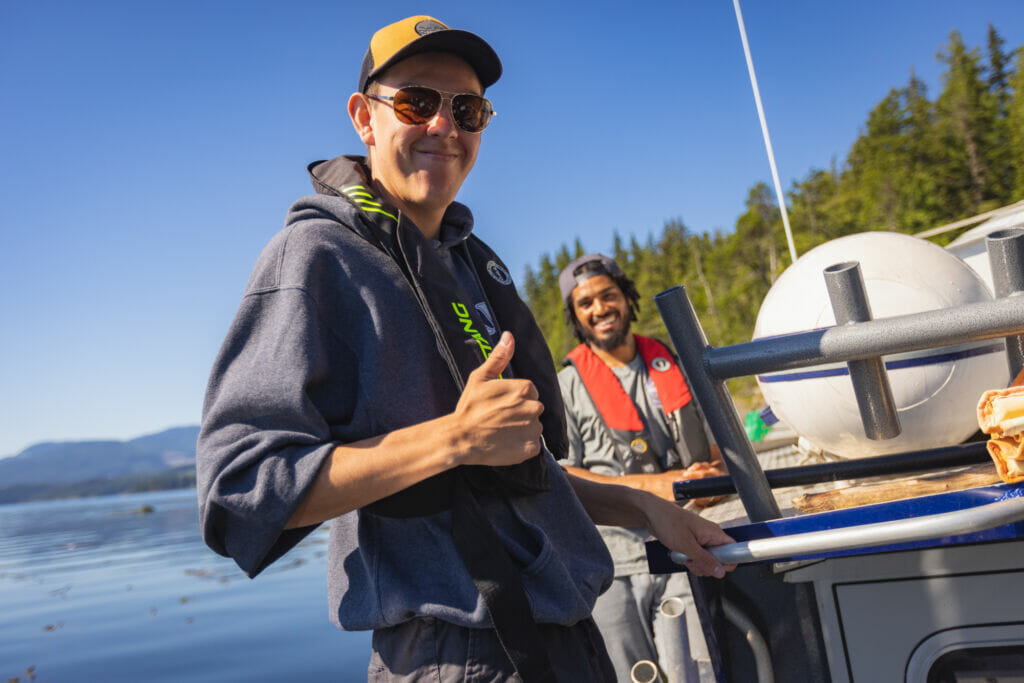
The Coast Conservation Endowment Fund Foundation has cumulatively approved $200,000 towards the Wei Wai Kum stewardship program’s start-up (2019) and annual operations (2020, 2021).
Partnerships
- Wei Wai Kum First Nation
- Na̲nwak̲olas Council
- Greenways Land Trust
- 7 Generation Stewards Society
- Coast Funds
- Guardians of the Mid-Island Estuary Society
- BC Natural Resource Office – Nanaimo Branch
- Fisheries and Oceans Canada
- A-Tlegay Fisheries Society
- Hakai Institute
- BC Timber Sales
- Brown Bear Research Network
- Pacific Salmon Foundation
- Indigenous Watersheds Initiative
Online Resources
- Reconnecting to the Homelands
Na̲nwak̲olas Council feature on the Wei Wai Kum Guardia program - “Kelping Up” With the Times
Na̲nwak̲olas Council feature on bull kelp survey techniques - Indigenous Guardians Toolkit: Wei Wai Kum First Nation
Background on the Wei Wai Kum Guardians - Learning the Land: Restoration and Education Collide on the Campbell River Estuary
News article on estuary restoration - Greenways Land Trust restores industrial log storage site in Campbell River estuary
News article on estuary restoration - Watershed Restoration Work Cultivates Opportunities and Community Connections
Healthy Watersheds Initiative story on the Wei Wai Kum’s partnership with the Greenways Land Trust
Published On October 11, 2022 | Edited On February 17, 2023


